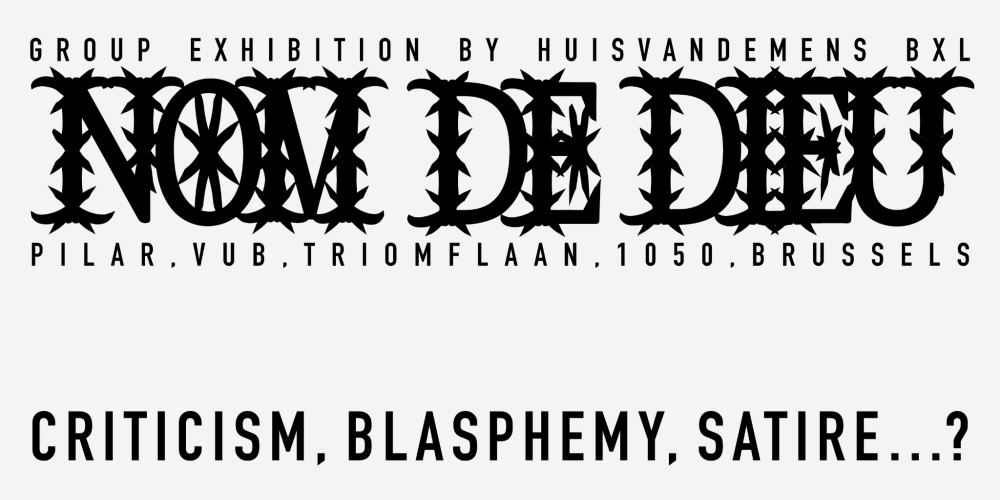
Practical
Pilar is easiest to reach via campus entrance 6 on Triomflaan.
The Vrije Universiteit Brussel, deMens.nu and Pilar invite you to explore the exhibition Nom de Dieu.
This exhibition curated by Prof. Em. Willem Elias and non-denominational morality teacher Kathleen Van Nuffel, showcases works by modern, high-profile Belgian artists. Many of the pieces reference Christianity and Catholicism. After all, Western culture remains deeply rooted in Christian traditions. Over two thousand years of influence from this worldview have left indelible traces, and this exhibition aims to reflect on those legacies.
Curator Willem Elias provides a unique perspective on blasphemy, diverging from its definition in the Oxford Dictionary:
"In the Oxford dictionary, 'blasphemy' is defined as 'the action or offence of speaking sacrilegiously about God or sacred things.' Since god does not exist, one cannot blaspheme him. Blasphemy is closer to heresy—an attitude of dissatisfaction with the way God is represented, seeking to improve faith. The purpose of this exhibition is not to commit blasphemy but to understand it through showcasing. Blasphemy is, after all, part of the methodology of free thinking. Better understanding this free thinking aligns with the objectives of secular organizations."
The exhibition features works by Félicien Rops | Marcel Mariën | Pjeroo Roobjee | Frank Maieu | Jan Van Imschoot | Jan Van Oost | Guillaume Bijl | Wim Delvoye | Liliane Vertessen | Dees de Bruyne | Ronny Delrue | Frank JMA Castelyns | Peter De Cupere | Axel Daeseleire | Freddy De Vierman | Raymond Minnen | Elke Andreas Boon | Jo De Smedt | Carmen De Vos | Bart Ramakers | Rob Vanoudenhoven | Tom Herck | Mr Donka | Peter Weidenbaum | Hilde Braet | Roland Minnaert.
As a visitor, you are encouraged to ask questions about blasphemy and blasphemous art, form your own opinions, and perhaps even reconsider your perspective.
SCROLL DOWN TO CONTINUE READING ABOUT THE EXHIBITION
- Admission is free but we do ask that tickets be booked in advance so that we can keep track of the number of visitors.
- Groups of up to 20 people can book through the ticket system.
- Guided tours for groups of 5 to 20 people are possible. Please send your request to brussel[at]demens.nu
OPENING HOURS
- From Wednesday to Saturday
- Every day from 2PM to 8PM
- Closed during winter holidays.
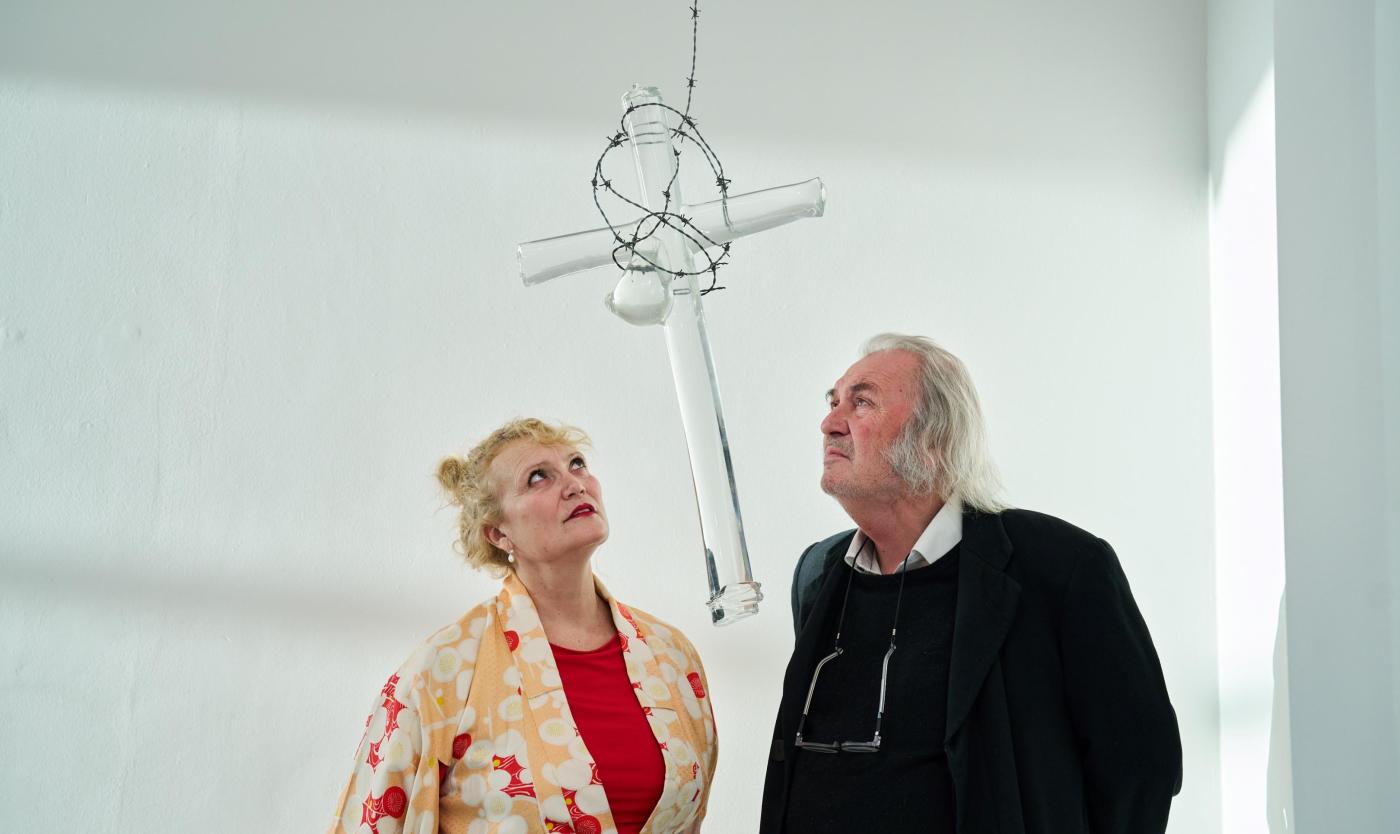
"The figure of Jesus has been depicted naked for centuries"
Kathleen Van Nuffel, a teacher of non-religious ethics, curates the exhibition alongside her husband, Professor Emeritus Willem Elias. "Art doesn’t harm anyone. Why should artists be silenced?"
Blasphemous art?
From the preface to the catalogue – by Jan Van den Brande (deMens.nu):
"This exhibition in no way intends to cast certain religious groups in a negative light. Although blasphemy is a central theme, we do not seek to be blasphemous ourselves. Instead, we aim to emphasise that criticism, satire, and blasphemy are integral elements of Western culture and art. Criticism, humour, satire, and parody have been part of artistic expression since the Renaissance, a tradition that was further reinforced by the Enlightenment and remains highly relevant today."
"What defines art is precisely its complexity and the potential for diverse interpretations. For instance, Tom Herck's Holy Cow can be seen, on the one hand, as a blasphemous representation of the crucified Christ and, on the other hand, as a reflection of our fragile animal condition, where the suffering and sacrifice of animals mirror Christ's own suffering."
"Freedom ceases to exist without the room to be critical or even offensive. Therefore, free inquiry—the freedom to explore reality through science or art—is a principle we must steadfastly uphold."
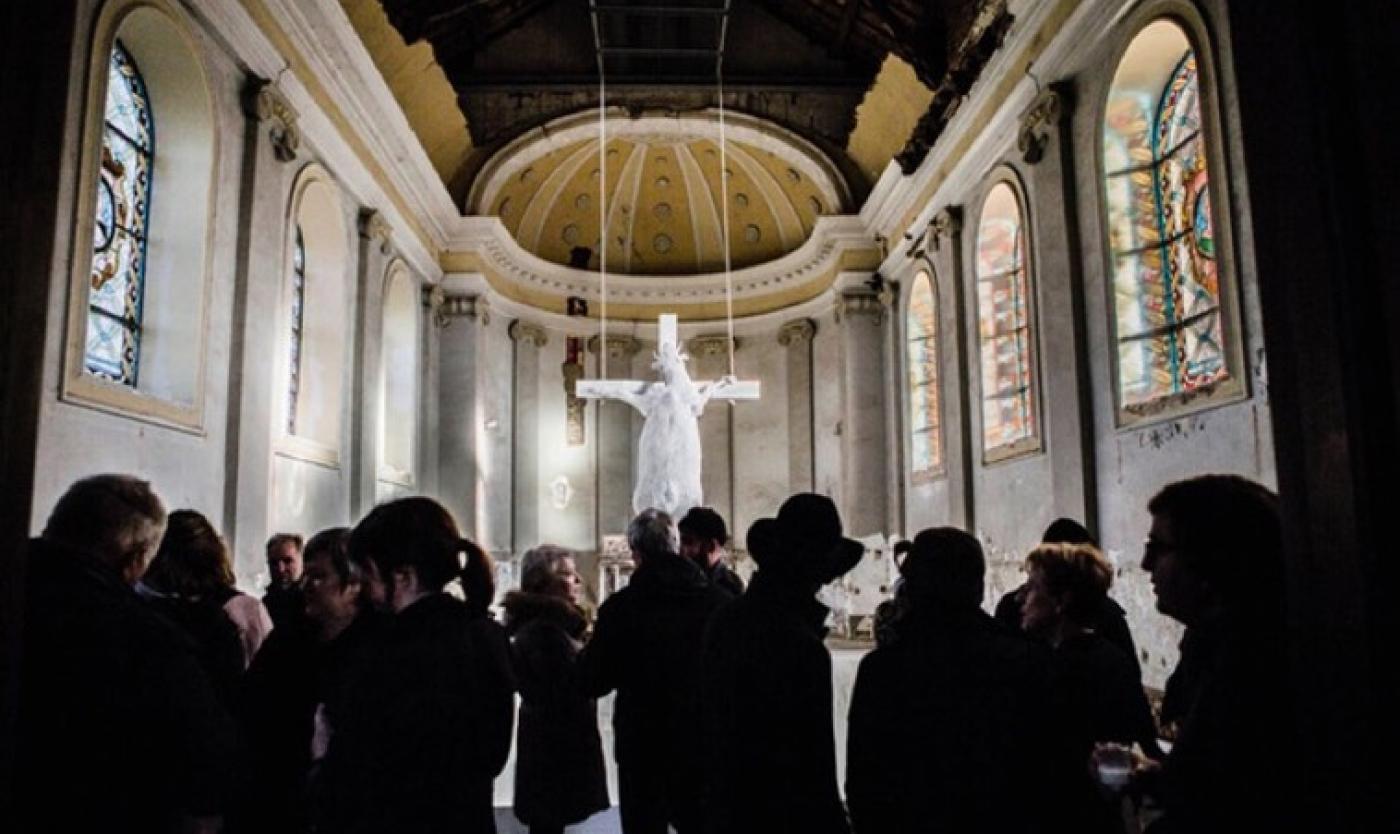
Holy Cow - 2017 - Fibreglass (polyster) 490 x 235 x 90 cm - 81 m2 Bath mixed with milk, water and milk powder - Tom Herck
Symbols and rituals
Religion is expressed through symbols and rituals, which can also give rise to blasphemous interpretations.
In 2017, in a deconsecrated church in Kuttekove (Belgium), Tom Herck presented a life-size crucified cow suspended above a puddle of 5,000 litres of milk. This installation critiqued humanity’s treatment of animals and food. However, ultra-religious Catholics interpreted it differently and vandalised the artwork. Now, the installation will be displayed on the VUB campus. A similar theme is explored in The Consumptions of the Suffering by Peter Weidenbaum. This piece features a bronze sculpture of a sacrificed goat hanging by a cord, reflecting on suffering as a central value of the Christian experience. Fragrance artist Peter De Cupere offers a different perspective on the divine: for him, heaven does not have an ethereal scent but the earthy smell of a body returning to the soil. In his work Madonna, the figure does not appear but disappears, challenging traditional representations.
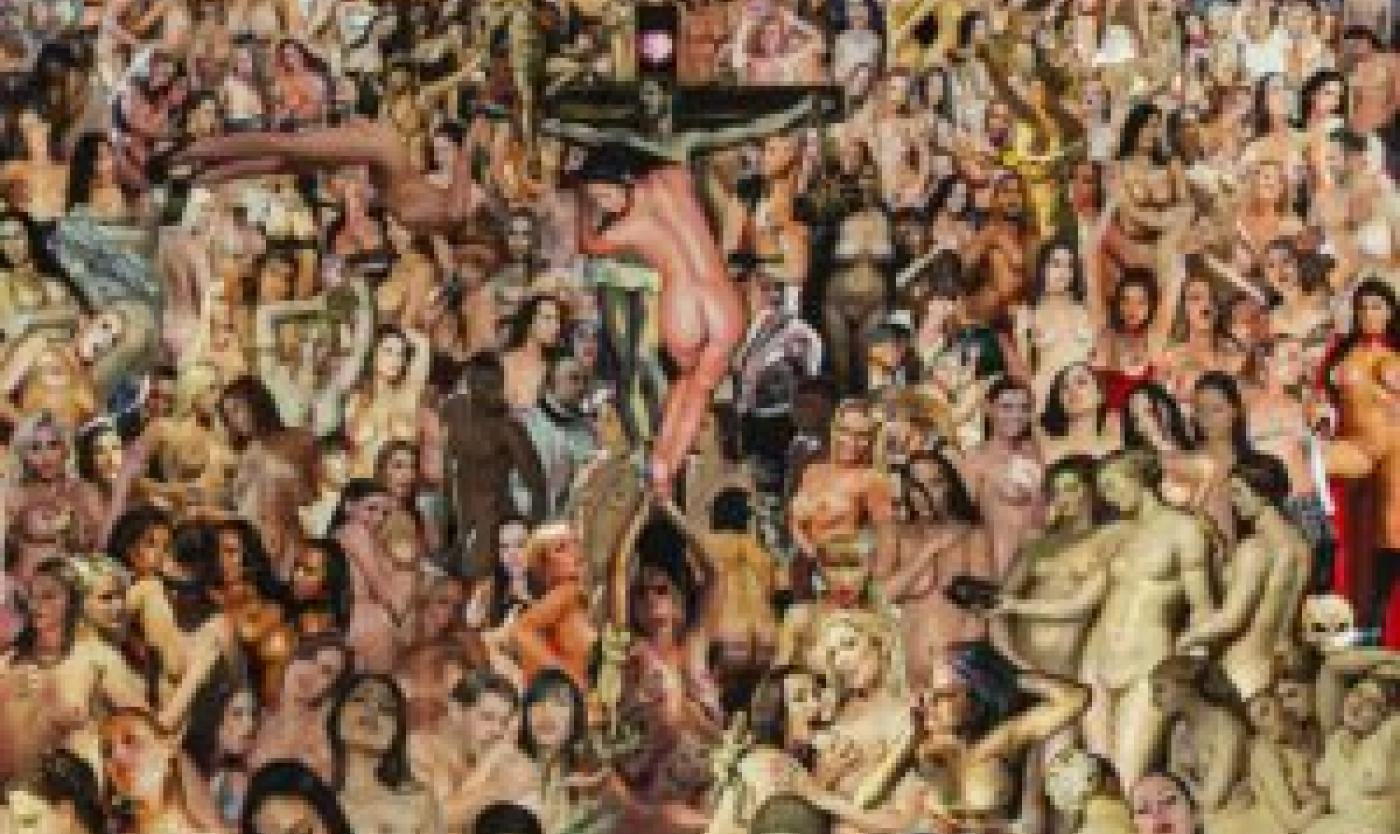
© Rob Vanoudenhoven ‘Tomorrowland’ - Collage, 75 cm x 75 cm, 2021
Erotics
The church's ambiguous attitude towards sexuality makes it a powerful catalyst for blasphemous themes in artistic iconography.
Félicien Rops (1833–1898) was a pioneer in this regard, transforming Christ on the cross into a grinning devil with an exaggerated erection. This theme also plays a significant role in the oeuvre of Carmen De Vos, who highlights a misunderstood female perspective on eroticism and religious repression. To the tones of Matthew Passion, Hilde Braet captures the facial expressions of masturbating men. Bart Ramakers creates heavenly atmospheres where eroticism and holiness intertwine. Roland Minnaert offers a May '68 perspective on religion, eroticism, and the sexual revolution of the era. Meanwhile, Rob Vanoudenhoven crafts a collage in the spirit of The Garden of Earthly Delights, but without Hieronymus Bosch's admonition against sin. In his work, women feast on the crucified Christ, reducing a suffering man to an object of lust.
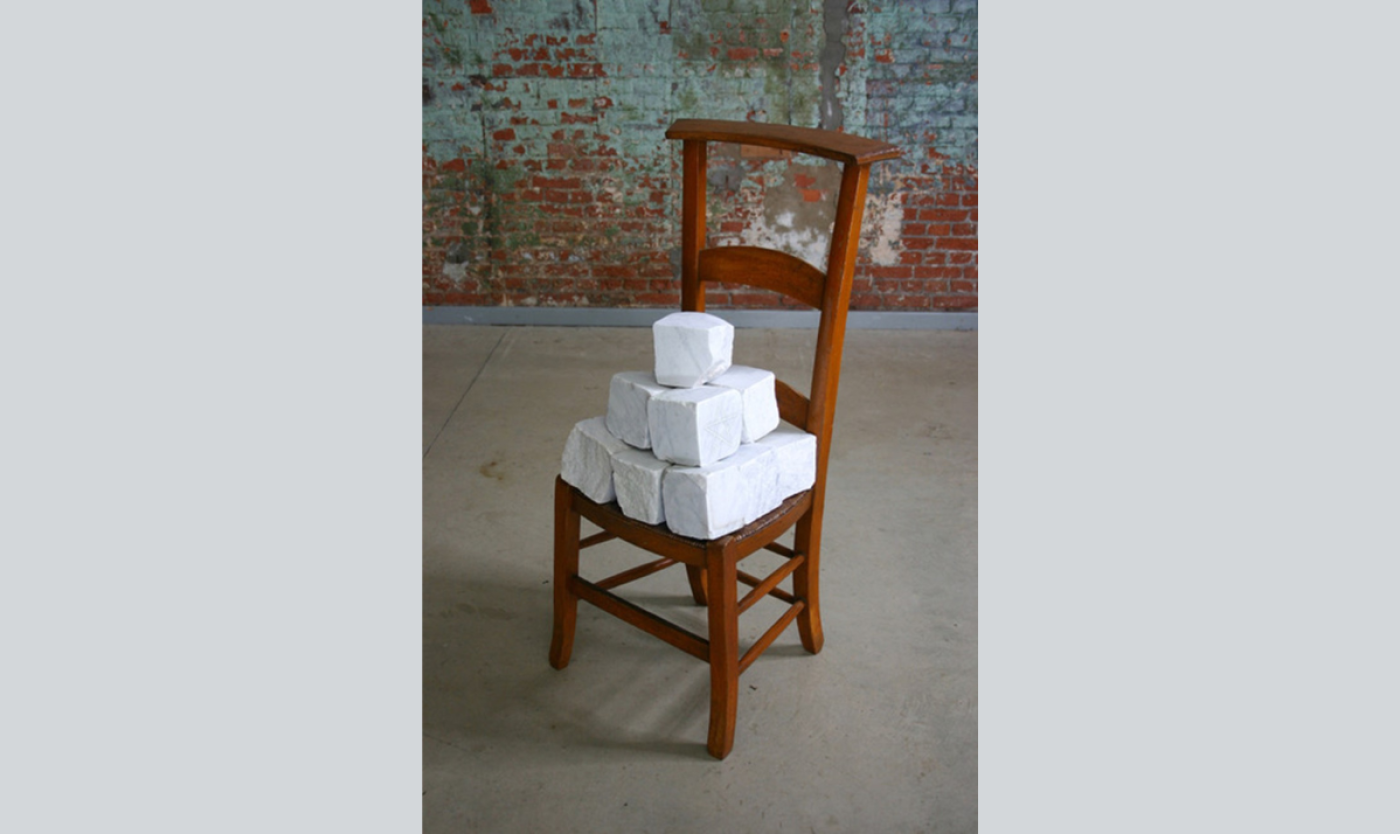
© Frank JMA Castelyns ‘Les poids et les mesures' - Wooden church chair, marble, phosphorescent paint, 97 cm x 43 cm x 49 cm, 2022
Commandments and prohibitions
How is it that morals and customs arise in cultures that make life no easier?
This moral heaviness is clear in the work of Frank JMA Castelyns. On an old church chair are a pile of cobblestones. The cobblestone may symbolise the step-by-step carpentry on the road of life. Carefully loaded on a seat, one acquires the meaning of a loaded existential weightiness. The ethical burden ingrained in our culture is represented by Pjeroo Roobjee through tormented figures. The crucified one exhibits feminine traits often in company with a guardian of the law with super-masculine traits. Ronny Delrue' s pope anointingly shows a blessing hand, the other degenerates into a snatching lecherous grasping claw. It is the pope who holds a hand over the ‘Children's Friends’, a work by Dees de Bruyne, on which child abuse by notables of church and state are denounced. Liliane Vertessen, one of the first Belgian artists to use one's own body as an artistic medium, is seen sitting distraught as a child. It suits her style of self-portraiture. Next to it is a crucifix surrounded by barbed wire. There is no escaping the kinship with Christ's crown of thorns, a symbol of suffering. In Jan Van Oost' s case, a barbed wire sets the tone in the confrontational reconciliation between cross and bosom. Elke Andreas Boon keeps a cool head. A Christ head between ping pong palettes, a Madonna statue dethroned, but grounded.
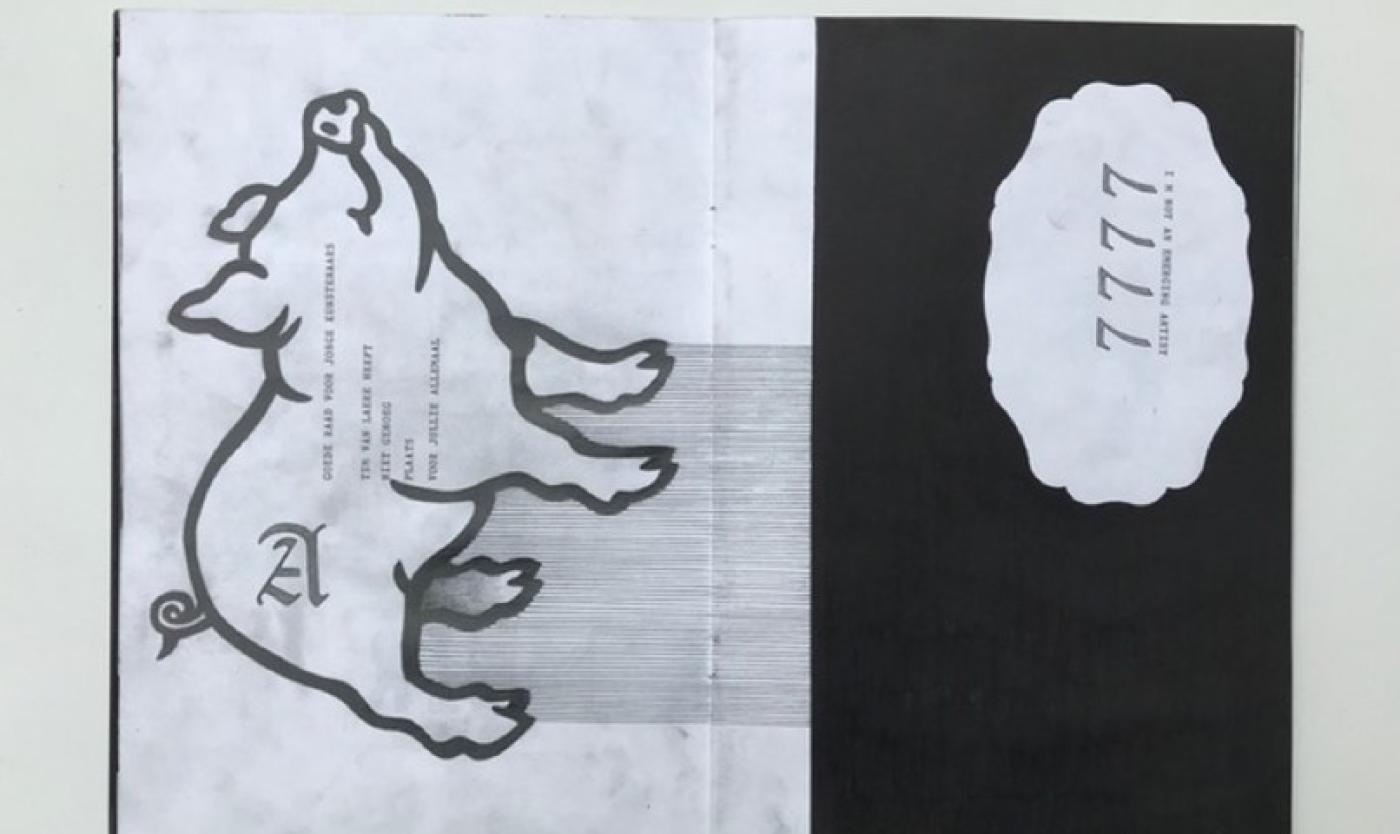
© Jo De Smedt “Meat Hook. Mixed media on paper (sketchbook), 30 cm x 42 cm, 2024
From the catalog of the expo Nom de Dieu (demens.nu)
Power
There are also artists for whom blasphemy involves subverting profane systems of power. Just as every religion is rooted in power, every exercise of power quickly takes on the characteristics of a religion. In his Gott ist tot concept, Nietzsche warns that the deceased deity will soon be replaced by another baseless power system. "Dieu est mort, vive dieu." After desacralisation comes resacralisation.
Visual artist Jo De Smedt critiques the art world itself. Painter Jan Van Imschoot takes aim at the political correctness associated with the Woke movement. According to Van Imschoot, what begins as an important movement for raising awareness about discrimination can quickly morph into a repressive moralistic system. In this system, the focus shifts away from fostering a more democratic understanding that embraces diversity and instead becomes about exclusion and repression. For this exhibition, Van Imschoot created a painting in response to a clash during the mounting of his retrospective at SMAK. A female curator objected to displaying works from his series on shemales. For Van Imschoot, the series is fundamentally about feeling at home in one’s own body.
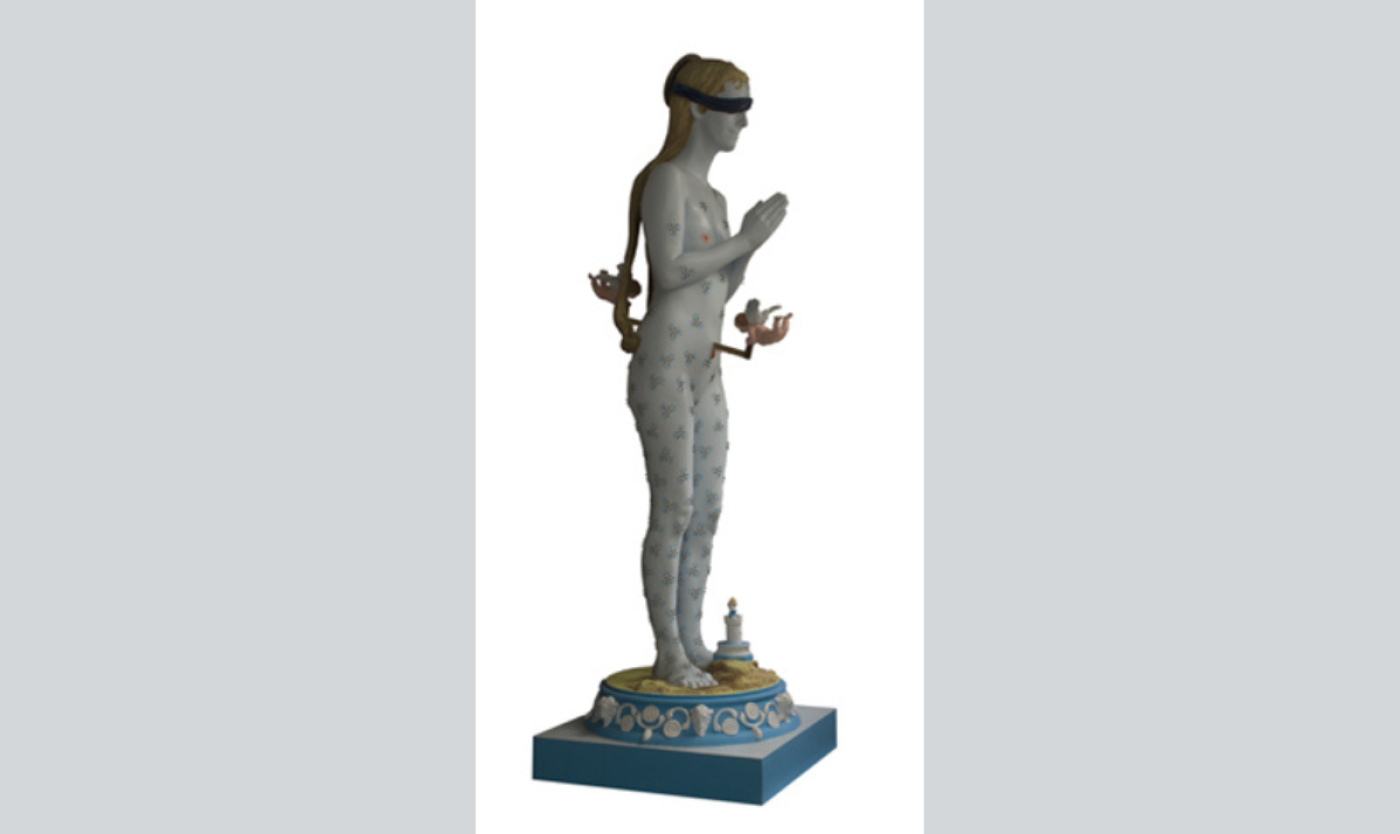
© Raymond Minnen 'Ivory Tower 2' - Painted plaster, 228 x 70 x 70 cm, 2002
Hypocrisy and desecration
The desecration of religious ritual objects and clerical theatricality is a recurring theme in the work of many artists. It plays a significant role in the oeuvre of sculptor Raymond Minnen and visual artist, painter, draughtsman, and graphic artist Freddy De Vierman.
Raymond Minnen explains:
"Take faith and politics. These are two things that essentially have nothing to do with each other. Yet, in my work, I often mix them because, very often, the same dynamics are at play. Christ and God promise paradise after death, while Lenin promises paradise before death. This concept translates into works like a water bottle shaped like Our Lady, as sold in Lourdes, but with her head replaced by Lenin’s, creating an entirely new whole. Or a bust of Lenin wearing the Pope’s cassock. I enjoy bringing two seemingly unrelated elements together and making them collide."
(Source: Gazet van Antwerpen)

© Guillaume Bijl ‘Liturgical Objects’
Installation, 2019
Blasphemous effect?
A characteristic of several works of art is that, despite their blasphemous themes, they have little to no blasphemous impact on most believers. To truly be perceived as a blasphemous act, strong faith is often required.
Guillaume Bijl explores this idea with his installation Liturgical Objects, created for the Museum of Religious Art Parcum in Heverlee Abbey. The installation featured a shop selling candles and crosses, symbolically offering a way to heaven. Positioned near the counter, many visitors believed the objects were genuinely for sale. Axel Daeseleire addresses the intersection of religion and war, while Marcel Mariën satirises the story of the carpenter's son. Wim Delvoye, internationally renowned for his Cloaca poop machine and tattooed pigs, tattooed a portrait of Christ onto pig skin. His cross enters the comic book world or transforms into a DNA chain. Frank Maieu's Christ can no longer face the world and hides behind the cross, while Mr Donka depicts the pregnant Holy Virgin with a Pinocchio nose.
The world needs you
This initiative is part of VUB's public programme: a programme for everyone who believes that scientific knowledge sharing, critical thinking and dialogue are an important first step to create impact in the world.
As an Urban Engaged University, VUB aims to be a driver of change in the world. With our academic edcuational programmes and innovative research, we contribute to the Sustainable Development Goals of the United Nations and to making a difference locally and globally.
Create more impact Receive invitations for VUB's public activities
TEACHER? VISIT THE EXPO WITH YOUR CLASS!
Third-grade secondary school students can visit the expo as a class.
The day programme for up to 100 pupils will then be as follows:
- 9.30am: Welcome and introduction to the theme by HuisvandeMens/House of Practical Humanism. Pupils are split into two groups of max. 50
- 10am: GROUP 1: Guided tour with assignments at the expo. GROUP 2: Film or theatre presentation on the topic.
- 12h: Lunch in the VUB restaurant
- 13h: GROUP 2: Guided tour with assignments on the expo. GROUP1: film or theatre performance on the subject.
- 15u: All students gather back together in one central location and exchange their findings. There is also an opportunity to ask further questions about the exhibition and the performance.
- 15:30: End
It is also possible to visit only the exhibition under supervision: max. 50 people.
Available dates for schools:
- Thursday 9 January 2025
- Tuesday 14 January 2025 (fully booked)
- Thursday 23 January 2025
- Tuesday 28 January 2025